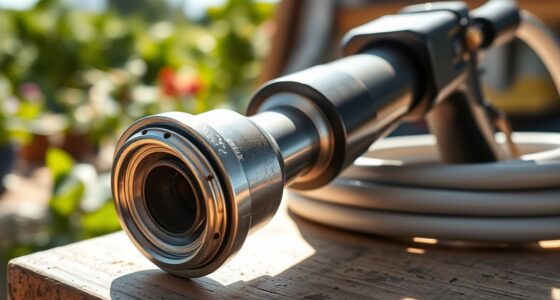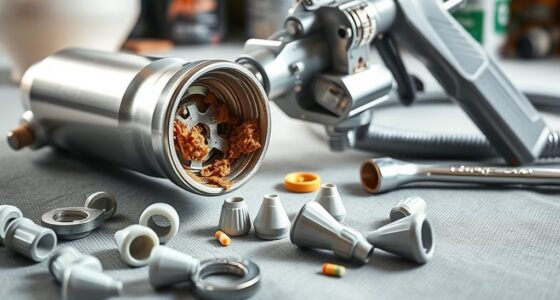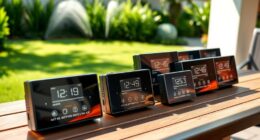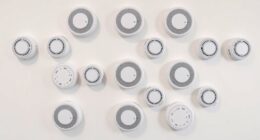When choosing between water-based and solvent-based primers, consider your surface and project timeline. Water primers dry faster, are easier to clean, and emit fewer fumes, making them ideal for quick projects and less challenging surfaces. Solvent primers work better on tough surfaces, fill imperfections, and provide stronger adhesion but require longer drying and proper ventilation. For the best results, follow specific application techniques and ventilation tips—continue exploring to master these priming best practices.
Key Takeaways
- Choose water-based primers for quick drying, easy cleanup, and low fumes; opt solvent-based for superior adhesion and stain blocking.
- Apply water primers evenly with quality brushes or rollers, avoiding overworking to prevent streaks; use compatible tools for solvent primers.
- Ensure surfaces are clean and dry before priming; solvent primers are better for challenging or imperfect surfaces.
- Ventilate well during application and drying, especially with solvent primers, to speed up drying and ensure safety.
- Match primer choice to project timeline: water-based for faster results, solvent-based for longer-lasting, durable finishes.

Choosing the right primer is essential for ensuring a smooth and durable finish on your project, and one of the key decisions is whether to prime with water or solvent-based products. Your choice impacts not only the adhesion and appearance but also how you handle primer techniques and drying methods. Water-based primers, also known as latex or acrylic primers, are popular because they’re easy to work with, clean up with soap and water, and emit fewer fumes. They tend to dry quickly, which can speed up your project. When applying water-based primers, your primer techniques should emphasize even coverage and proper surface preparation. Use a high-quality brush or roller, and avoid overworking the material, which can lead to uneven coats. Since water-based primers dry rapidly, you need to work efficiently to prevent lap marks or streaks. Proper drying methods are vital here; usually, they dry to the touch within 30 to 60 minutes and are ready for painting in a couple of hours. Ensuring good ventilation accelerates drying and helps avoid trapping moisture. Additionally, selecting a primer with adequate color fidelity ensures consistent color throughout your project.
On the other hand, solvent-based primers, often oil-based or alkyd primers, are known for superior adhesion on challenging surfaces, stain blocking, and filling imperfections. Yet, they require different primer techniques. Because these primers tend to be thicker, they benefit from using a solvent-compatible brush or roller and sometimes a sprayer for smooth application. You should take your time to apply them evenly, avoiding drips or pooling. Drying methods for solvent-based primers take longer—often several hours or overnight—because they evaporate solvents slowly. Good ventilation is critical here, not just to speed up drying but also to ensure safe fumes are vented out. You might need to wait longer before applying the next coat or topcoat, which could extend your project timeline. Proper application and drying techniques are essential for achieving optimal results with either primer type.
Frequently Asked Questions
Which Primer Type Offers Better Long-Term Adhesion?
You’ll find that solvent-based primers generally offer better long-term adhesion, especially in challenging conditions. They provide superior adhesion durability and primer longevity by penetrating surfaces more effectively and resisting moisture and temperature changes. Water-based primers are more environmentally friendly but may not hold up as well over time in demanding environments. For the best long-term results, choose a solvent primer if adhesion durability and primer longevity are your priorities.
Can Water-Based Primers Be Used on Non-Porous Surfaces?
You might think water-based primers are only for porous surfaces, but they can surprisingly work on non-porous ones too—if you select the right primer for compatibility. While surface porosity usually guides your choice, some water-based primers are specially formulated to bond with non-porous materials like plastic or metal. Just check the manufacturer’s recommendations to confirm you choose a primer designed for your specific surface, ensuring a strong, lasting adhesion.
Are Solvent Primers Suitable for Indoor Use?
Yes, solvent primers can be used indoors, but you should consider eco-friendly options due to fumes and VOCs. Confirm surface compatibility before application, especially on non-porous surfaces. Good ventilation helps, and choosing low-VOC or environmentally friendly solvent primers reduces health risks. Always follow manufacturer instructions for safe indoor use, and if you’re concerned about environmental impact, explore eco-friendly options that still deliver strong adhesion and surface compatibility.
How Do Environmental Conditions Affect Primer Effectiveness?
Environmental conditions critically impact primer effectiveness. High humidity can hinder proper adhesion and drying, so you should avoid applying primers during damp weather. Temperature considerations are also vital; extreme heat speeds up drying, potentially compromising bond strength, while cold temperatures slow it down. To guarantee ideal results, apply primers in stable conditions, ideally between 50-85°F, and monitor humidity levels to prevent issues caused by environmental fluctuations.
What Are the Drying Times for Water vs. Solvent Primers?
Ever wonder how quickly your primer dries after application? Water-based primers typically dry within 30 minutes to an hour, depending on environmental conditions, while solvent-based primers can take 1-2 hours. The drying process depends on factors like humidity and temperature, so proper application techniques, such as thin coats and good ventilation, help speed up drying. Always check manufacturer instructions for specific drying times to guarantee the best results.
Conclusion
So, which priming method works best for you: water or solvent? Consider your specific needs, the materials involved, and safety factors. Both have their advantages, but the key is understanding when to use each effectively. Don’t you want to guarantee your project’s success with the right priming choice? Remember, choosing wisely can save you time, money, and hassle down the line. Make an informed decision and get your project primed for success!
Franz came aboard the Paint Sprayer Zone team with a background in both journalism and home renovation. His articulate writing style, combined with a passion for DIY projects, makes him an invaluable asset. Franz has a knack for breaking down technical jargon into easy-to-understand content, ensuring that even the most novice of readers can grasp the complexities of paint sprayers.










